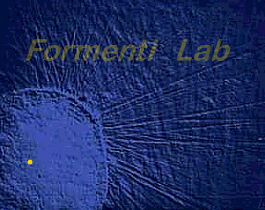


Changes in K+ and/or Ca2+ concentrations in the cerebrospinal fluid can alter the rhythmic thalamo-cortical electrogenesis
Effects on EEG rhythms are seen in many pathological states primarily involving calcium metabolism, such as hyperparathyroidism and
vitamin D poisoning, or in other conditions in which the extracellular calcium concentration [Ca2+]o is secondarily influenced, such
as malignancies, renal failure, and some disorders of the endocrine system. During persistent hypercalcaemia, various neuropsychiatric
symptoms can be present, including a state ranging from drowsiness to lethargy, and there is low frequency electroencephalographic
(EEG) activity.
In vivo experiments from our laboratory showed that intraventricular CaCl2 injections in freely moving adult rats tripled
the EEG amplitude and increased the relative power of the low EEG frequencies, with a decrease of the fast activity confirming the
primary involvement of calcium ions in central nervous system functional alterations.
The thalamic neurons play an important role in the electro-cortical rhythms. They fire with single spikes during wakefulness (relay
mode), and oscillate and synchronise their firing, producing bursts of action potentials, during slow-wave sleep (oscillatory mode).
The rhythms arise as a consequence of the intrinsic pacemaker property of the neurons and the network of excitatory and inhibitory
synaptic connections within the thalamus and between the thalamus and the cortex.
The crucial parameter controlling the transition
from relay mode to oscillatory mode and viceversa is the resting membrane potential of the thalamo-cortical neurons.
Our research
show that increasing the extracellular calcium concentration [Ca2+]o alone induced a transition of the discharge from single spike
to burst mode in isolated current-clamped neurons and
These findings shed light on the correlation between hypercalcaemia, low frequency
EEG activity and symptoms such as sleepiness and lethargy described in many clinical papers.
Electroencephalographic (EEG) activity during normal wakefulness (left) and after the intraventricular infusion of CaCl2 (right)
On the other hand, it is known that at low [Ca2+]o seizures are sometimes observed from different structures in the brain. Seizures are also induced by an increase in extracellular [K+] or other agents that can also induce depolarisation. Interestingly enough, many anti-epileptic drugs have hyperpolarizing effects, and can induce drowsiness.
Multiple mechanisms of control of the thalamic relay and pacemaker activity
Changes of [K+]csf and/or [Ca2+]csf altering the membrane potential can modify the thalamo-cortical firing. It is suggested that whereas the hyperpolarizing effects lead to neuronal burst discharge and EEG synchronisation, the depolarising effects of low [Ca2+](csf) or an increase in [K+](csf), lead to a lower frequency pathological burst discharge and epileptic seizures. This latter activity, at least in some cases, may involve enhanced Na+ influx through INa,P (Li & Hatton, 1996) rather than LVA Ca2+ currents that, in turn, cause neuronal burst discharge during SWS-EEG synchronisation. In addition, the reduction in [Ca2+]csf that may occur during paroxysmal neuronal activity can act as a positive feedback, activating a Ca2+-sensitive depolarising current, leading to further depolarisation and hyper excitability. (Formenti et al. 2001).
PAPERS
- FORMENTI, A., ARRIGONI, E., MARTINA, M., TAVERNA, S., AVANZINI,G. & MANCIA, M. (1995). Calcium influx in rat thalamic relay neurons
through voltage-dependent calcium channels is inhibited by enkephalin. Neuroscience Letters 201, 21–24.
- FORMENTI, A., MARTINA, M., DE SIMONI, A. & MANCIA, M. (1998) An external Ca2+ increase hyperpolarizes rat thalamic neurons blocking
an inward current. Society for Neuroscience Abstracts 24,814.10.
- A. Formenti, A. De Simoni, E. Arrigoni and M. Martina (2001). Changes in extracellular Ca2+ can affect the pattern of
- FORMENTI, A., ARRIGONI, E. & MANCIA, M. (1996). Effects on the electroencephalogram induced by the changes in cerebrospinalfluid Ca2+-concentration:
cellular mechanisms. Society for Neuroscience Abstracts 22, 64.16.
- FORMENTI, A. & DE SIMONI, A. (2000). Effects of extracellular Ca2+ on membrane and seal resistance in patch-clamped rat thalamic and
sensory ganglion neurons. Neuroscience Letters 279, 49–52.
Informativa sulla Privacy


